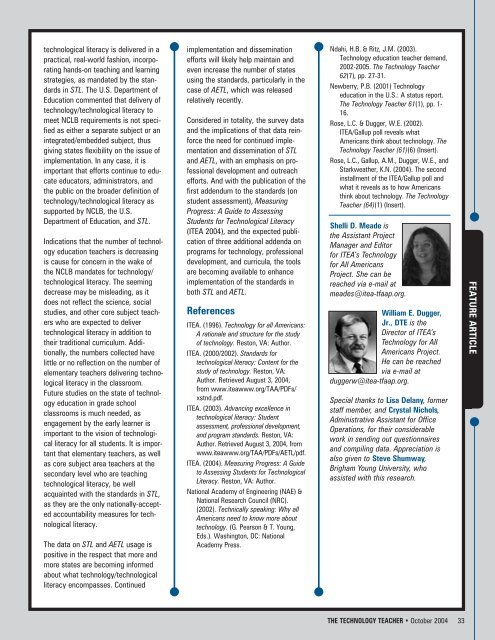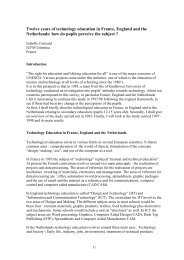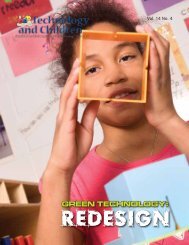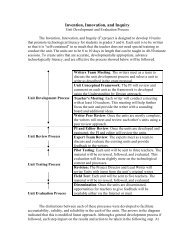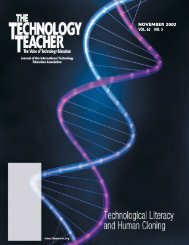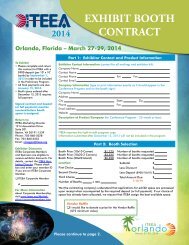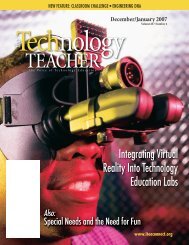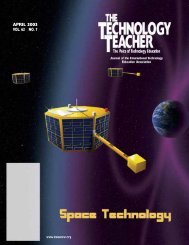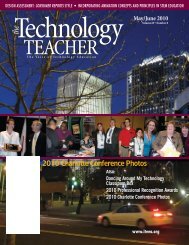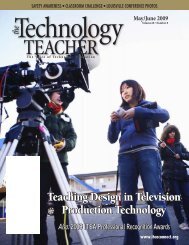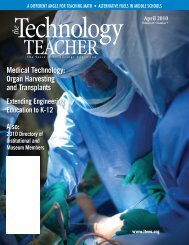October 2004 - Vol 64, No.2 - International Technology and ...
October 2004 - Vol 64, No.2 - International Technology and ...
October 2004 - Vol 64, No.2 - International Technology and ...
- No tags were found...
Create successful ePaper yourself
Turn your PDF publications into a flip-book with our unique Google optimized e-Paper software.
technological literacy is delivered in apractical, real-world fashion, incorporatingh<strong>and</strong>s-on teaching <strong>and</strong> learningstrategies, as m<strong>and</strong>ated by the st<strong>and</strong>ardsin STL. The U.S. Department ofEducation commented that delivery oftechnology/technological literacy tomeet NCLB requirements is not specifiedas either a separate subject or anintegrated/embedded subject, thusgiving states flexibility on the issue ofimplementation. In any case, it isimportant that efforts continue to educateeducators, administrators, <strong>and</strong>the public on the broader definition oftechnology/technological literacy assupported by NCLB, the U.S.Department of Education, <strong>and</strong> STL.Indications that the number of technologyeducation teachers is decreasingis cause for concern in the wake ofthe NCLB m<strong>and</strong>ates for technology/technological literacy. The seemingdecrease may be misleading, as itdoes not reflect the science, socialstudies, <strong>and</strong> other core subject teacherswho are expected to delivertechnological literacy in addition totheir traditional curriculum. Additionally,the numbers collected havelittle or no reflection on the number ofelementary teachers delivering technologicalliteracy in the classroom.Future studies on the state of technologyeducation in grade schoolclassrooms is much needed, asengagement by the early learner isimportant to the vision of technologicalliteracy for all students. It is importantthat elementary teachers, as wellas core subject area teachers at thesecondary level who are teachingtechnological literacy, be wellacquainted with the st<strong>and</strong>ards in STL,as they are the only nationally-acceptedaccountability measures for technologicalliteracy.The data on STL <strong>and</strong> AETL usage ispositive in the respect that more <strong>and</strong>more states are becoming informedabout what technology/technologicalliteracy encompasses. Continuedimplementation <strong>and</strong> disseminationefforts will likely help maintain <strong>and</strong>even increase the number of statesusing the st<strong>and</strong>ards, particularly in thecase of AETL, which was releasedrelatively recently.Considered in totality, the survey data<strong>and</strong> the implications of that data reinforcethe need for continued implementation<strong>and</strong> dissemination of STL<strong>and</strong> AETL, with an emphasis on professionaldevelopment <strong>and</strong> outreachefforts. And with the publication of thefirst addendum to the st<strong>and</strong>ards (onstudent assessment), MeasuringProgress: A Guide to AssessingStudents for Technological Literacy(ITEA <strong>2004</strong>), <strong>and</strong> the expected publicationof three additional addenda onprograms for technology, professionaldevelopment, <strong>and</strong> curricula, the toolsare becoming available to enhanceimplementation of the st<strong>and</strong>ards inboth STL <strong>and</strong> AETL.ReferencesITEA. (1996). <strong>Technology</strong> for all Americans:A rationale <strong>and</strong> structure for the studyof technology. Reston, VA: Author.ITEA. (2000/2002). St<strong>and</strong>ards fortechnological literacy: Content for thestudy of technology. Reston, VA:Author. Retrieved August 3, <strong>2004</strong>,from www.iteawww.org/TAA/PDFs/xstnd.pdf.ITEA. (2003). Advancing excellence intechnological literacy: Studentassessment, professional development,<strong>and</strong> program st<strong>and</strong>ards. Reston, VA:Author. Retrieved August 3, <strong>2004</strong>, fromwww.iteawww.org/TAA/PDFs/AETL/pdf.ITEA. (<strong>2004</strong>). Measuring Progress: A Guideto Assessing Students for TechnologicalLiteracy. Reston, VA: Author.National Academy of Engineering (NAE) &National Research Council (NRC).(2002). Technically speaking: Why allAmericans need to know more abouttechnology. (G. Pearson & T. Young,Eds.). Washington, DC: NationalAcademy Press.Ndahi, H.B. & Ritz, J.M. (2003).<strong>Technology</strong> education teacher dem<strong>and</strong>,2002-2005. The <strong>Technology</strong> Teacher62(7), pp. 27-31.Newberry, P.B. (2001) <strong>Technology</strong>education in the U.S.: A status report.The <strong>Technology</strong> Teacher 61(1), pp. 1-16.Rose, L.C. & Dugger, W.E. (2002).ITEA/Gallup poll reveals whatAmericans think about technology. The<strong>Technology</strong> Teacher (61)(6) (Insert).Rose, L.C., Gallup, A.M., Dugger, W.E., <strong>and</strong>Starkweather, K.N. (<strong>2004</strong>). The secondinstallment of the ITEA/Gallup poll <strong>and</strong>what it reveals as to how Americansthink about technology. The <strong>Technology</strong>Teacher (<strong>64</strong>)(1) (Insert).Shelli D. Meade isthe Assistant ProjectManager <strong>and</strong> Editorfor ITEA’s <strong>Technology</strong>for All AmericansProject. She can bereached via e-mail atmeades@itea-tfaap.org.William E. Dugger,Jr., DTE is theDirector of ITEA’s<strong>Technology</strong> for AllAmericans Project.He can be reachedvia e-mail atduggerw@itea-tfaap.org.Special thanks to Lisa Delany, formerstaff member, <strong>and</strong> Crystal Nichols,Administrative Assistant for OfficeOperations, for their considerablework in sending out questionnaires<strong>and</strong> compiling data. Appreciation isalso given to Steve Shumway,Brigham Young University, whoassisted with this research.FEATURE ARTICLETHE TECHNOLOGY TEACHER • <strong>October</strong> <strong>2004</strong> 33


